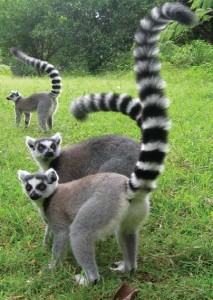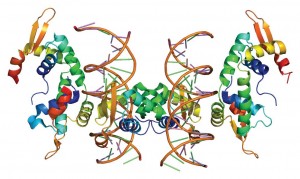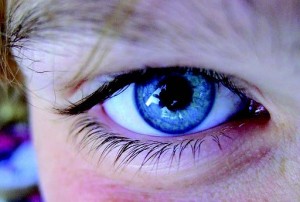MONDAY, 3 FEBRUARY 2014
The world is shrinking. We are more connected than we have ever been, and faster and more convenient ways of sharing our lives arrive by the minute. ‘Communication’ has been the buzzword of the last two decades, but the idea goes beyond online news feeds, beyond Skype and Facebook. Analyse the workings of the organic world at any level, be it the microscopic organelles of individual cells, or vast, intricately structured colonies of organisms, and you will see that in every Tweet and Snapchat is reflected a process vital for life.Whilst it may seem an obvious statement that communication is the transfer of information, it wasn’t until the late 1940s that this was formalised as ‘information theory’. Proposed by Claude E. Shannon to mathematically quantify communication, this branch of probability has had numerous applications in a huge number of fields, from economics to quantum physics. Furthermore, Shannon’s insight made possible the development of mobile phones and the internet. It might be said that it was he who laid the foundations of the digital revolution.
Shannon schematized communication to include a source, a signal, and a receiver. The fundamental idea is that whilst the quantity of information transmitted from source to receiver is that contained within the signal, the information communicated depends on the increase in the receiver’s knowledge as a result of getting the message. If the receiver is fairly certain what the message is going to say, this increase is small, thus the information communicated is minimal, whereas if the receiver starts out ignorant, then the information communicated can be much larger. Therefore the amount of information acquired is an intrinsically subjective concept, dependent on the receiver’s expectations of the message.
Information theory helps quantify and compare the efficiency of different communication channels and codes. For example, digital text written in the English alphabet is typically transmitted in American Standard Code for Information Interchange (ASCII). Here, each character is assigned a sequence of zeros and ones of eight digits long (A being 01000001; B 01000010). This is eight bits, or a byte, of information. The number of possible arrangements of such a sequence is 256, thus allowing for coding of 256 different characters. Since words in English have on average 6 characters long communications systems using ASCII transmit about 48 bits of information for each word. Information theory tells us that a more efficient alternative would be to label the words rather than the letters. Assuming there are 500,000 words in English we would need to assign 19 bit labels to every word, in which case we only need 19 bits of information for conveying a word.
If we consider that words like “the” appear more often than words like “hypochondriac”, we can use this probability to construct a more efficient code. Shannon arranged the English words according to the frequency of their use, and divided that list using a 50 per cent threshold. Words that accounted for 50 per cent of all usage were left in the upper part and the rest in the lower part. Shannon repeated this procedure giving a “0” to a word every time it fell on the upper half and a “1” when it fell in the lower side. As there are fewer words that are very frequent these words ended up having a shorter string than less common words, which produced a far more efficient code.
Information theory is widely employed by intelligence services to develop techniques for communicating international secrets securely. Before the 20th century, linguistic tools were used to encrypt messages, but now computational and mathematical methods make codes much harder to break. The most sophisticated of these “cryptosystems” cannot be broken even if the adversary has unlimited computing power. An example of these is the one- time pad encryption, used first used in WWII and then again between Moscow and the United States during the cold war. In this encryption each character from the text is encrypted by the addition of a character from a secret random key (or pad) that has the same length as the text. It is impossible to decode the text if you do not know the key.
In the natural world, information transmission is present at all levels of organisation, from molecular or electrical communication between single cells to visual, auditory, tactile and even electromagnetic communication between whole organisms. If the information capacity of a signal is defined by the number of possible messages it can convey, communication systems in living organisms cover a wide range of capacities. For example, individual sensory neurons in the human nervous system can only communicate the intensity of a single stimulus at a particular location, which has relatively few possible states. However, communication between neural networks in the cerebral cortex has a much higher information capacity, capable of representing whole objects or ideas.
One should be wary of implying that high capacity communication systems are more important than those with a low capacity. Take bacteria for example. By definition, these are single-celled organisms; but perhaps we shouldn’t think of them as individual lone-rangers, rather as microscopic ants contributing to a colony. Bacteria ‘talk’ using a molecular system of communication known as ‘quorum sensing’, which is only ‘switched on’ when the bacterial colony has grown to reach a critical population density. In this system, the molecular signal transmitted by each cell contains little information but can be used to activate a range of functions with maximum efficiency – some of which have important results for other species, including humankind.
Quorum sensing enables bacteria to coordinate their activity, in order to achieve functions that can only be effective when carried out in unison by a large population, rather than by individuals. For example, aggressive and defensive mechanisms, such as the production of toxins, would have negligible effects if performed by only one or a few bacteria, but can be devastating when carried out en masse: the effect of cholera toxins (produced by Vibrio cholerae bacteria) is just one of many examples. Reproductive mechanisms such as the transfer of DNA to (known as conjugation), and the production of spores are also triggered by quorum sensing, these being somewhat useless pastimes for the solitary bacterium.
Perhaps the most aesthetically pleasing example of quorum sensing is in the organism in which the phenomenon was first discovered. Vibrio fischeri is a bacterium found throughout the oceans, though in barely noticeable amounts. It luminesces, but only when it inhabiting, as happens when it lives inside the specialised light organs of certain deep-sea organisms. The relationship between the two species is symbiotic: bacteria trade their light in return for the sugars and amino acids provided by the host. This arrangement has evolved twice in two different host species, which use the luminescence for quite different purposes. In the monocentrid fishes, such as the pineapple fish, the light is used to assist feeding at night, illuminating the small shrimp that are their prey. Conversely, in sepiolid squid, such as the Hawaiin Bobtail squid, the luminescence is used to cancel out their silhouette, so as to hide them from prey.
However, quorum sensing also has a dark side. The bacterium Pseudomonas aeruginosa is so virulent it causes disease in organisms from the weed Arabidopsis thaliana all the way to humans, where it is responsible for the majority of deaths in cystic fibrosis patients. It is renowned for forming biofilms when concentrations of the bacteria get too high. Biofilms are groups of cells attached to a surface and their formation has serious consequences as it makes bacteria notoriously hard to kill with antibiotics.
Quorum sensing is not invulnerable to disruption, however. Bacteria do it themselves by destroying other bacteria’s signalling molecules, rendering them unable to communicate. Synthetic inhibitors of quorum sensing would have widespread clinical applications, as biofilm formation could be prevented, making bacterial infections easier to tackle with antibiotics. A more every-day application would be to put these quorum-sensing blockers into toothpaste and so prevent the build-up of plaque. Now that should bring a smile to your face!
Chemical signals, known as pheromones, are widely used in nature, not just by bacteria. Often, their purpose is to define territories through scent marking and to attract mates by signalling fitness or readiness to mate. The ring-tailed lemur, however, uses scent to compete for mates. Instead of signalling to the opposite sex, males signal their fitness to other males. They anoint their tails with secretions from the scent glands on their wrists, holding them above their heads and waving them as they approach a competitor in an attempt to drive him off.
Pheromones are also used to guide foraging, with ants following pheromone trails left by others to find food sources. This can lead to the formation of a ‘circle of death’. If two ants both follow each other, or one ant follows its own trail, they move in a circle. Other ants from the colony, following their trails, join them and the ants then circle until they die of starvation or exhaustion.
Of course, many of nature’s most striking displays are not chemical but visual signals, which are commonly used for species recognition and mate attraction. The distinctive red face of the bald-headed uakari monkey accomplishes both these purposes, with the exact hue of a male’s face influencing his mating success. Whilst neither intentional nor conscious, this signal constitutes communication as it transmits information about the male’s physical health and genetic fitness. Sick animals have paler faces, so those most resistant to malaria have the brightest faces. This may explain why female monkeys have evolved to prefer males with brighter faces.
Visual signals are also used more purposefully; one example being the waggle dance of the honeybee. The signal communicates information about the environment, indicating the distance and direction of a food source, and thus guides its receivers to the resource. Some have argued that this sophisticated communication system is a language: it is governed by rules, symbolic, and always carried out in front of an audience. Others have countered that, unlike human language, it has no syntax, is almost exclusively genetically encoded, and its symbols are directly related to what they represent.
Unlike visual signals, which take time to be noticed, vocal signals enable swift communication and so are often used to signal threats. The alarm calls of vervet monkeys are predator-specific, allowing individuals to respond to a threat appropriately– a leopard’s warning call causes them to take to the trees, whereas an eagle’s warning call causes them to run into dense bush. Many species, including birds, gibbons, and wolves, use song as a means of marking territorial boundaries, particularly if the information must be communicated to distant receivers or in environments where visual signals are hard to see, for example the dense rainforest canopy.
Vocal calls are also used to coordinate group behaviour, as when a pack of African hunting dogs pursues prey. Here, communication of information enables cooperation, acting as a mechanism of unification. This is also the usual purpose of tactile signals, an important means of social bonding for many animals. In wolves, behaviours such as muzzle- licking are used to signal submission in accordance with the pack hierarchy, while primates groom one another to both form and reinforce alliances.
Amongst animal communication systems one stands out: our very own. Several properties distinguish human language from even the most complex of other animal communication systems. The first and most obvious difference is the fact that we can talk about virtually anything. As ordinary as discussing the weather or what you had for dinner last night might seem, in reality, the fact we can expound on such diverse topics is remarkable. Animal communication usually consists of a limited set of discrete messages with fixed meanings, whereas language is entirely ‘generative’: that is, its units can be recombined in infinite ways to convey information limited only by the imagination of the speaker.
Although words are arbitrary symbols, it is possible they play a key role in linking our visual, auditory and tactile perception of the world. For instance, our idea of ‘a cat’ relies on mental representations of what a cat looks like, how it is meant to sound and what it feels like. It has been argued that the word ‘cat’ itself allows us to combine these attributes to form a cohesive concept used for thinking and communicating. Perhaps surprisingly, it seems that language can also shape the very structure of our thoughts: certain words convey unrelated connotations that can become associated with the more obvious aspects of the word’s meaning. One example of this is in languages that assign a gender to otherwise genderless words. In Spanish and German, inanimate objects have genders, some of which are reversed between the two languages. Spanish speakers asked to grade the objects these words refer to on a gender scale gave ‘manly properties’ to those whose words are masculine in Spanish, while German speakers thought of them with feminine characteristics.
Human language is not only impressive because of the complexity of meaning each word can convey, but because of the information communicated by syntax: the organisation of words into sentences. For each language, syntax is governed by a set of well-defined rules, grammar. Knowledge of this allows us to decode the information contained in the structure of a sentence. For example, ‘Jane hits John’ means something quite different from ‘John hits Jane’: our knowledge of the English ‘subject-verb-object’ rule facilitates understanding of this.
Interestingly, the processing of syntax by the brain appears to occur unconsciously. Researchers have recorded electrical currents from the brains of human participants, a technique known as EEG, whilst getting them to listen to sentences, some of which were grammatically incorrect. At the same time, the participants had to perform a complex task in order to distract them. Although most people showed characteristic ‘surprise’ responses to almost all the incorrect sentences, when explicitly asked about them they often did not spot the errors, indicating a lack of conscious awareness. It seems that comprehending language is an automatic process.
However remarkable language is, whether it arose as a complete novelty in humans or as a modification of a precursor animal communication system, remains a hotly debated issue. Although the brain mechanisms that determine language are far from understood, it is at least clear that human speech employs neural circuits different from those used for vocalisation in animals. Quite excitingly, the genetic basis of humans’ capacity for language is beginning to be uncovered. For instance, mutation in one specific gene appears to be common in sufferers of a certain language impairment. This gene encodes for forkhead box protein 2 (FOXP2), responsible for activating many other genes. While it is not known how exactly FOXP2 might shape the neural circuits that allow language acquisition, it seems to be involved in the maturation of the brain and the development of the capacity for language. FOXP2 belongs to a highly conserved family of proteins, the human version is very similar to the non-human primate one. However, most of the differences that do exist occurred around the time that modern humans appeared. This seems to be one of the events that shaped the evolution of the human brain.
Impressive though human language is, one cannot ignore the fact that the song “You say it best when you say nothing at all” has been a three- time chart topper in the past four decades. Clearly, non-verbal communication has been a prevalent subject even in pop culture, and justifiably so – an estimated two-thirds of all our communication is without language. Non-verbal communication is the transmission of information, wordlessly between a sender and receiver(s). The different means at our disposal for this are use of the pitch and tone of voice (paralanguage), the eyes (oculesics), touch (haptics) and gesture (kinesics). This form of communication is among the first to be imbibed from our environment, certainly before we adopt the use of words and a system of language.
Paralanguage deals with the intangible factors encountered in speech: tone, rhythm, pitch, and volume. In most cases, it is these factors that portray the emotion of a spoken sentence. For these reasons, speech can convey mood and feeling without the need for description, as opposed to text where sometimes the absence of paralanguage makes it difficult to discern intention. A common example we might relate to is the likelihood of misunderstanding text messages and e-mail as opposed to voice conversation, even if they are identical in content.
Another communication channel particularly integral to human expression is eye contact. In fact, it is thought that the white part of the eye, the sclera, evolved in response to the social demands of our existence. The human sclera is more conspicuous than in other animals and may have made communication via gaze easier to interpret, aiding social interaction and learning in pre-verbal children. It is a widely accepted idea that emotions like happiness, sadness or anger can be better gauged by looking at the eyes than from a person’s smile or frown. It is a common notion that the eyes are a perfect giveaway of lies, as people with something to hide exhibit minimal eye contact. However, this may not always be true. A study observed that in police interviews, both deceptive and truthful suspects maintained the same amount of eye-contact. Indeed, the liars, by blinking less often, sometimes appeared more convincing than those telling the truth.
The basis of non-verbal communication is an open question, and debate often centres on the age-old nature versus nurture dichotomy, though in reality, both genes and environment are likely to play a role. Pre-verbal infants communicate through gestures and facial expression, only some of which are learnt from their environment. Identical twins who were raised apart display similar body language. Even non- human primates share some facial expressions similar to humans. The part of the brain responsible for instinctive responses, emotions and social judgement is the limbic system and to an extent may be pre-programmed to exhibit certain aspects of non-verbal communication. On the other hand, it appears that much of our non-verbal communication is influenced by culture. The same non-verbal expression may mean different things in different social groups and this understanding between the sender and receiver of communication becomes crucial. For instance, where eye contact may indicate confidence, honesty and attentiveness in some cultures; others consider bold eye contact as disrespectful. Similarly, kissing or even handshakes assume different levels of acceptability in different societies.
Non-verbal communication plays a bigger role in our day-to-day life than we think, as it provides a means by which people may judge our personality. Given the job market of today, this idea is gaining increasing interest as it becomes apparent that one needs not only to ‘talk the talk’, but also ‘walk the walk’ to gain competitive advantage. Whether we are aware of it or not, it seems we are always communicating through these subtle channels. Try closing your eyes, standing still or walking out of the room; as long as there is an audience, every action will have communicated some information. We can choose to stop talking but we never stop communicating.
Ornela De Gasperin is a 4th year PhD student at the Department of Zoology
Nathan Smith is a 2nd year Natural Sciences student at Churchill College
Tam Stojanovic is a 2nd year Natural Sciences student at Pembroke College
Ana Leal Cervantes is is a 3rd year PhD student in the Department of Hematology
Shirin Ashraf is 2nd year PhD student in the Department of Immunology









